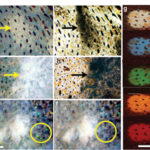White reflection from cuttlefish skin leucophores
the skin of cephalopods is admired by biologists for its ability to camouflage quickly and effortlessly with its environment. This feat is accomplished via several layers of cells: chromatophores, which contain pigment granules which expand and contract to display color, iridophores, which reflect light of particular wavelengths structurally using refraction, and leucophores which reflect ambient and white light. This study examines the interplay and proportion of leucophores compared to iridophores in different cuttlefish skin sections to assess the role each plays in presenting a particular color, especially true bright whites.
Learn about our two Decals!
 Click here to find out more about our Fall Bioinspired Design Decal and our Spring Bioinspired Design in Action Decal – ALL MAJORS are welcome.
Click here to find out more about our Fall Bioinspired Design Decal and our Spring Bioinspired Design in Action Decal – ALL MAJORS are welcome.Berkeley BioDesign Community
 Click here to learn about the BioD: Bio-Inspired Design @ Berkeley student organization or here to signup for more info.
Click here to learn about the BioD: Bio-Inspired Design @ Berkeley student organization or here to signup for more info.Search
Student Login




I imagine that the neurological circuits underlying these processes are governed by both 2d spacing maps with their brains as…
to reduce the impact of car accidents, it may be possible to study the force diverting physics of cockroaches to…
you see this type of head-bobbing stability in many avian creatures related to pigeons like chickens. the head ability to…
not like they taught horses how to run! this is an example of convergent evolution where both sea creatures and…
The brain functions in a similar way with neuronal connections. our brains are able to utilize the multiplicity of connections…